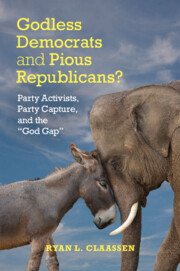Book contents
- Frontmatter
- Dedication
- Contents
- Figures
- Tables
- Acknowledgments
- Introduction
- 1 The Religious Divide in American Politics
- 2 Mobilization, Capture, and Misunderstood Trends
- 3 Representation and Four Forces that Shape Change Among Activists
- 4 First Force, The Effect of Being Fruitful and Multiplying
- 5 Second Force, The Effect of Voting Early and Often
- 6 Third Force, The Effect of Picking a Side
- 7 Fourth Force, The Effect of Writing Checks and Knocking on Doors
- 8 “Capture” Revisited, Representation, and Religious Activists
- 9 Conclusion
- Appendix A Coding for the Major Religious Traditions
- Appendix B Frequencies for Change Factor Computations
- Appendix C The Raw Materials for Assessing the Role of Demographic Change in the Activist Pools
- Appendix D Voter Loyalty Trend Estimates with Additional Control Variables
- Appendix E Republican Voter Loyalty Among Evangelicals and Region Versus Religion
- Bibliography
- Index
3 - Representation and Four Forces that Shape Change Among Activists
Published online by Cambridge University Press: 05 June 2015
- Frontmatter
- Dedication
- Contents
- Figures
- Tables
- Acknowledgments
- Introduction
- 1 The Religious Divide in American Politics
- 2 Mobilization, Capture, and Misunderstood Trends
- 3 Representation and Four Forces that Shape Change Among Activists
- 4 First Force, The Effect of Being Fruitful and Multiplying
- 5 Second Force, The Effect of Voting Early and Often
- 6 Third Force, The Effect of Picking a Side
- 7 Fourth Force, The Effect of Writing Checks and Knocking on Doors
- 8 “Capture” Revisited, Representation, and Religious Activists
- 9 Conclusion
- Appendix A Coding for the Major Religious Traditions
- Appendix B Frequencies for Change Factor Computations
- Appendix C The Raw Materials for Assessing the Role of Demographic Change in the Activist Pools
- Appendix D Voter Loyalty Trend Estimates with Additional Control Variables
- Appendix E Republican Voter Loyalty Among Evangelicals and Region Versus Religion
- Bibliography
- Index
Summary
Although the implications of the changing religious affiliations of partisan activists have received a good deal of attention, surprisingly little is known about the sources of those changes. It is generally assumed that increases in the size of a group in an activist pool are the result of mobilization, but prior scholarship has not considered other factors – especially whether composition changes in the activist pools reflect more general composition changes in society at large. Accordingly, this chapter develops a more complete approach to understanding the rising tide of Evangelical Republican activists on the right and Secular Democratic activists on the left. Broadly, the representation-based approach posits that changes in the activist pools result from basic social and political forces – including, but not limited to – political mobilization. A new approach is needed because changes in the activist pools appear much more menacing when produced by mobilization alone. Indeed, the idea that large parties can be “captured” by relatively small groups is a nonstarter absent massive political mobilization. The representation-based approach models other forces – forces with far less worrisome implications than massive political mobilizations. In identifying the key elements that determine a group's size in the activist pool, the representation-based approach demonstrates the important role mobilization can play shaping the activist pools – but also highlights important connections between the composition of the activist pools and several social and political changes that have little or nothing to do with mobilization.
The representation-based approach identifies four elements that determine a group's size in an activist pool. The logic is simple. The number of group members serving as activists for a party is a function of the size of the group in the general public (demographics), the number of members that participate in electoral politics (turnout), the number of members that support the party in elections (voter loyalty), and the number of members that are willing to get involved with the campaign beyond voting (rate of activism).
- Type
- Chapter
- Information
- Godless Democrats and Pious Republicans?Party Activists, Party Capture, and the 'God Gap', pp. 36 - 44Publisher: Cambridge University PressPrint publication year: 2015



